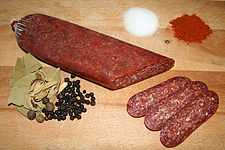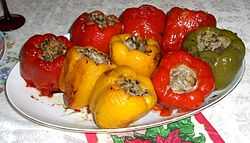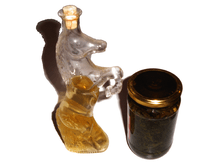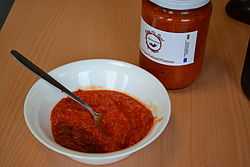Bulgarian cuisine
| Part of a series on |
| Bulgarians българи |
|---|
 |
| Culture |
|
| By country |
| Subgroups |
|
| Religion |
| Language |
|
| Other |
|


Bulgarian cuisine (Bulgarian: българска кухня, bylgarska kuhnja) is a representative of the cuisine of Southeastern Europe. Essentially South Slavic, it shares characteristics with other Balkans cuisines. Bulgarian cooking traditions are diverse because of geographical factors such as climatic conditions suitable for a variety of vegetables, herbs and fruit. Aside from the vast variety of local Bulgarian dishes, Bulgarian cuisine shares a number of dishes with the Greek, Middle Eastern, and Italian cuisines.
Bulgarian food often incorporates salads as appetizers and is also noted for the prominence of dairy products, wines and other alcoholic drinks such as rakia. The cuisine also features a variety of soups, such as the cold soup tarator, and pastries, such as the filo dough based banitsa, pita and the various types of Börek.
Main courses are very typically water-based stews, either vegetarian or with lamb, goat meat, beef, chicken or pork. Deep-frying is not common, but grilling - especially different kinds of sausages - is very prominent. Pork is common, often mixed with beef or lamb, although fish and chicken are also widely used. While most cattle are bred for milk production rather than meat, veal is popular for grilling meats appetizers (meze) and in some main courses. As a substantial exporter of lamb, Bulgaria's own consumption is notable, especially in the spring.[1]
Similarly to other Balkan cultures the per capita consumption of yogurt (Bulgarian: кисело мляко, kiselo mlyako, lit. "sour milk") among Bulgarians is traditionally higher than the rest of Europe. The country is notable as the historical namesake for Lactobacillus bulgaricus, a microorganism chiefly responsible for the local variety of the dairy product.[2][3] Yogurt has been cultivated and consumed as far back as 3000 BC.[4]
Bulgarian cuisine shares a number of dishes with the Middle Eastern Cuisine as well as a limited number with the Indian, particularly Gujrat cuisine. The culinary exchange with the East started as early as 7th century AD, when traders started bringing herbs and spices to the First Bulgarian Empire from India and Persia via the Roman and later Byzantine empires.[5] This is evident from the wide popularity of dishes like moussaka, gyuvetch, kyufte and baklava, which are common in Middle Eastern cuisine today. White brine cheese called "sirene" (сирене), similar to feta, is also a popular ingredient used in salads and a variety of pastries.
Holidays are often observed in conjecture with certain meals. On Christmas Eve, for instance, tradition requires vegetarian stuffed peppers and cabbage leaf sarmi, New Year's Eve usually involves cabbage dishes, Nikulden (Day of St. Nicholas, December 6) fish (usually carp), while Gergyovden (Day of St. George, May 6) is typically celebrated with roast lamb.
Traditional Bulgarian foods




Cold cuts
- Lukanka
- Sujuk
- Sazdarma
- Black pudding
- Karnacheta
- Bahur
- Banski Starets
- Strandjanski Dyado
- Pacha
- Elenski but
Soups
- Tarator
- Bob chorba
- Shkembe chorba
- Kurban chorba
- Teleshko vareno (Boiled veal meat and vegetables soup.)
- Tomato soup with cheese
- Supa Topcheta(Soup with little meatballs.)
- Cold Gardening soup (Traditional from Zheravna.)
- Fisherman's soup
- Chicken soup
- Mushroom soup
- Nettle soup
- Milk soup with or without cheese
Salads and relishes
- Shopska salad
- Snow White salad or Milk salad (similar to tzatziki)
- Milk salad with baked peppers
- Ovcharska (Shepard's) Salad
- Easter Salad (Traditional Easter salad with sliced boiled eggs, with dressing - oil and vinegar, and topped with mixed spice Sharena sol.)
- Salad with Carrots and Cabbage
- Bean salad
- Turshiya
- Kyopolou
- Potato salad
- Green salad (lettuce, green onion, radish, cucumber, salt, oil and vinegar.)
- Green salad with yogurt
- Salad with sliced peppers, garlic, oil and vinegar
- Mussel salad
- Fish and onion salad (traditionally from Pomorie.)
- Chiroz (Bulgarian Stockfish.)
Sauces and appetizers
- Lyutenitza
- Ljutika (spicy sauce)
- Apetitka
- Pindjur
- Ajvar
- Kyopolou
- Podluchen sauce or yogurt sauce (yogurt with garlic, oil, paprika, salt and sometimes dill.)
- Katak
- Razyadka
- Thracian walnut appetizer
Hot appetizers
- Katino meze (Hot starter with chopped pork meat, onion, mushrooms with fresh butter and spices.)
- Drob po selski (Chopped Liver with onion, or only with butter.)
- Ezik v maslo (Sliced tongue in butter.)
- Sirene pane (Breaded Bulgarian White cheese bites.)
- Kashkaval pane (Breaded Kashkaval bites.)
- Mussels in butter (With onion and fresh herbs, traditionally from Sozopol.)
Skara (grill)

- Kyufte (meatballs of minced beef and pork meat, seasoned with traditional spices and shaped in a flattened ball)
- Kebapche (similar to meatballs, but seasoned with cumin and shaped in a stick)
- Parjola (pork steak, chop or flank)
- Shishcheta (marinated pieces of chicken and/or pork and vegetables.)
- Karnache (a type of sausage with special spices)
- Nadenitsa (a type of sausage with special spices)
- Tatarsko kyufte (stuffed meatballs)
- Nevrozno kyufte (very piquant meatballs)
- Chicken in caul
- Cheverme (used in celebrations such as weddings, graduations and birthdays: a whole animal, traditionally a pig, but also chicken or a lamb, is slowly cooked in open fire, rotated manually on a wooden skewer from 4 to 7 hours.)
- Meshana skara (mixed grill)
- Grilled vegetables (usually a garnish or a side dish)
- Grilled fish (salt water or freshwater)
Main dishes
- Gyuvech
- Yahniya
- Plakiya
- Sarma
- Drob Sarma
- Wine, Tepsi or Tas kebab
- Kavarma
- Kapama
- Mish Mash (Popular summer dish made with tomatoes, peppers, onion, feta cheese, eggs and fresh spices)
- Pilaf (Rice with chopped meat, vegetables or mussels)
- Chomlek
- Mlin
- Stuffed courgettes
- Stuffed peppers
- Peppers börek
- Roasted beans
- Beans with sausage
- Pork with rice
- Roasted Chicken with Potatoes
- Pork with Cabbage
- Chicken with Cabbage
- Roasted Potatoes
- Drusan kebab
- Rice with chicken
- Tatarian Meatball
- Meatball(s) with White Sauce Stew
- Kjufteta po Chirpanski (Meatballs with potatoes; a recipe from Chirpan)
- Meatloaf 'Rulo "Stephanie"'
- Potato balls with Sauce
- Panagyurishte-Style Eggs
- Fried Courgettes with Yogurt Sauce
- Chicken in katmi (Popular in a "Thracian" variety)
- Fish Zelnik (With Sauerkraut and Rice)
- Fish in pastry (Usually in celebration of St. Nicholas)
- Stuffed Carp or Nikuldenski Carp (Prepared for the Feast of St. Nicholas)
Breads and pastries
- Pita
- Sweet Pita
- Pita with Meat (Variably with Mushrooms or with Tomatoes and Onion.)
- Pogacha (Usual ritual bread.)
- Kravai (Usual ritual bread.)
- Kolak (Usual ritual bread.)
- Banitsa (The most popular pastry in Bulgaria with a number of varieties.)
- Tikvenik (Banitsa with pumpkins)
- Zelnik (Banitsa with cabbage)
- Baklava
- Saraliya
- Parlenki
- Patatnik
- Kachamak
- Byal Mazh
- Tutmanik
- Milinka
- Gevrek
- Kozunak
- Mekitsi (Deep fried kneaded dough made with yogurt and eggs)
- Marudnitsi
- Katmi (a variety of pancakes)
- Palachinki (a variety of crêpes)
- Langidi
- Tiganitsi (Similar to Mekitsi)
- Dudnik
- Popara
- Sulovar
- Parjeni filii, "fried toasts"
- Kiflichki with jam or white cheese
- Solenki
- Yufka
- Trienitsa or Skrob
- Trahana
Dairy Products

Bulgaria as a homeland of yogurt has a strong tradition in the making of a variety of dairy products.
- Sirene
- Kashkaval
- Kiselo mlyako (Made by a culture of Lactobacillus bulgaricus and Streptococcus thermophilus)
- Tsedeno mlyako (Strained yogurt)
- Smetana
- Izvara
- Urda
- Katak
- Zira
Sweets
The name Halva (халва) is used for several related varieties of the Middle Eastern dessert. Tahan/Tahini halva (тахан/тахини халва) is the most popular version, available in two different types with sunflower and with sesame seed. Traditionally, the regions of Yablanitsa and Haskovo are famous manufacturers of halva.




- Pumpkin Dessert
- Baklava
- Buhti with yogurt
- Cookies "Peach" or Praskovki
- Fruit bread
- Garash cake ("Torta Garash")
- Katmi with jam or honey and/or cheese (Today usually with added chocolate)
- Kazanlak Donuts
- Kompot
- Kozunak
- Kurabiiki
- Lokum
- Maslenki
- Milk with Rice
- Oshav
- Tart with cherries or sour cherries (Traditionally from Bobov dol)
- Tart with different fruits
- Tatlii
- Tikvenik
- Tulumbichki
Spices and herbs
- Summer savory (Chubritsa)
- Spearmint (Djodjen)
- Sharena sol
Other staples
- Yoghurt ("Kiselo Mlyako", lit. sour milk)
- Honey ("Med")
Traditional Bulgarian drinks


Wine
- Mavrud
- Pamid
- Gamza
- Melnik wine
- Dimyat
- Misket
- Muskat
- Nohan or Lipa
- Divachka
- Shivka
- Rubin
- Tamyanka
Distilled liquors
- Rakia
- Slivovitsa
- Gyulova Rakia (Rose Rakia)
- Muskat Rakia
- Mastika
- Menta
Beer
Fermented beverages
- Boza (Most popular recipes are from Radomir and Lyubimets)
- Ayran or Ayryan
- Matenitsa (Bulgarian Buttermilk)
- Etar
- Pitie (Drinks prepared from different squeezed fruit or herbs, whose juice is usually kept for several days to a month before consumption)
Hot beverages
- Tea (Usually prepared with one or several herbs and/or fruits)
- Greyana Rakiya (boiled rakiya; winter alcoholic beverage)
- Greyano Vino (winter alcoholic beverage)
See also
- European cuisine
- List of cuisines
- Cuisine of the Mediterranean
- Eastern European cuisine
- Macedonian cuisine
References
- ↑ (April 2006). "Bulgaria Poultry and Products Meat Market Update." Thepoultrysite.com. Accessed July 2011.
- ↑ http://www.timesofmalta.com/articles/view/20110822/food-drink/Bulgarians-celebrate-the-art-of-true-homemade-yoghurt.381345
- ↑ http://cbs-sci.blogspot.com/2005/02/want-to-live-100-years-eat-bulgarian_02.html
- ↑ http://www.slimntrim.com/Bulgarian_Community/original_secret_of_bulgarian_yog.htm
- ↑ Zlatarski - Българската кухня през вековете p 78-79
External links
- Bulgarian Cuisine
- Many recipes from Bulgarian Cuisine
- Bulgarian Cuisine = Nutritious and Delicious
- Cuisineeurope - Bulgaria
- Eating the Bulgarian way
- Bulgarian Traditional Dishes
- 100 Essential Bulgaria Recipes
| ||||||||||||||
| ||||||||||||||||||
| ||||||||||||||||||||||||||||||||||||||||||||||||||||||
| |||||||||||||||||||||||||||||||||||||||||






